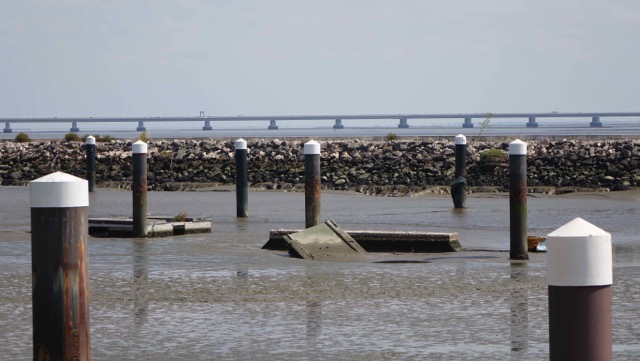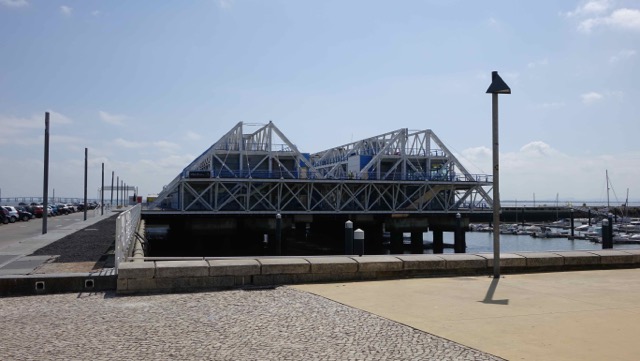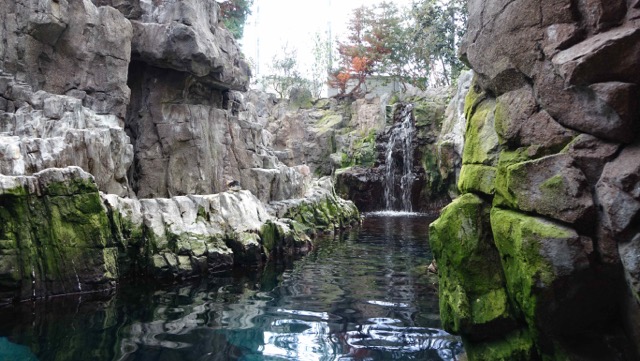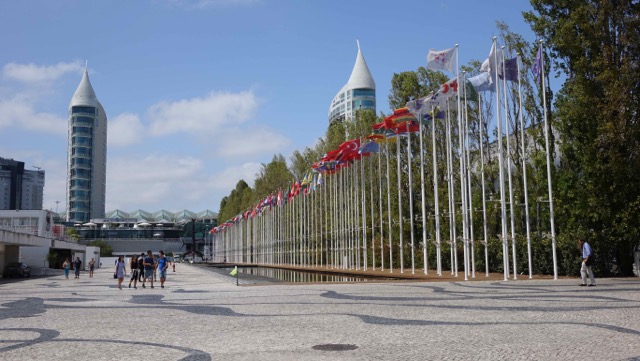38 45.313N 009 05.615W

Date: Friday 11th September 2015 Position: Moored
in the Marina Parque das Nações, Lisbon Owning and living on a small boat comes with its downside most notable being its size. There is never enough room to stretch out or even swing a cat if I had one. I don’t just mean actually stretch out, although that too can be a problem, but general life aboard is constrained by your physical surroundings. Everything becomes more complicated and time consuming. For example, a simple task like washing up takes longer; making the bed up takes longer and so on and so fourth. When I am in the middle of cooking a meal and the gas runs out I have to empty the starboard locker in the cockpit before I can get to the gas bottle to change it. Sometimes I wished I had a bigger boat but then I think about the up side of life aboard a small boat. As well as complicating life in some ways in other ways it can make it much simpler. You don’t have room to store lots of gear so all the crap and unnecessary accouterments of life you normally gather about you have to go. You only carry what is necessary and by extension you only spend money on what is necessary instead of becoming a slave to fashion and commercialism. When I say necessities I include beer in this category. There is always room for beer just like there is always room for that last piece of Nan bread left over after you have already stuffed your face full of curry and rice. One of the best things about owning a small boat is it is less expensive to run and maintain than a larger boat. I need two tins of antifouling to cover my bottom. Not my actual bottom you understand it is not that enormous although some of you might disagree. On a much larger boat I would need three or even four tins to do the same job and at an average of £100 a tin the cost soon mounts up. Marina fees are charged by the meter so the bigger the boat the bigger the marina costs. And so the list goes on. Sailing is not a cheap hobby by any means so keeping costs down is important for me being a pensioner and all. As the saying goes “you should always cut your cloth according to your means” and I think I have achieved that with Celtic Dawn. She is not the flashiest boat in the marina but she got me there safely and will continue to do so. I am currently moored in a marina where I am probably the smallest boat, surrounded by 49 footers worth hundreds of thousands of pounds. But at the end of the day when you break it down, we are all doing the same thing albeit they might be doing it in a little more luxury. Another aspect of owning boat, which is not quantifiable in terms of monetary value, size, etc., is the fact that you eventually bond with it until it becomes a good friend. I love my boat! She has done everything I have ever asked of her and she has looked after me these passed eight years or so. Over that time I have explored every nook and cranny and completed what was virtually a complete refit just before embarking on this adventure. I have poked and prodded around in the darkest of her corners and over the course of this we have become intimate friends. Of course I keep looking at other boats and dreaming about what it would be like to have something bigger, but I always come back to the same point. She is a good sturdy boat, I know her well, I can sail her alone and I can afford to maintain her. If I had money to spend I would much prefer to spend it on sailing and exploring the world than replacing what is already the perfect boat for me. Whilst writing about Celtic Dawn in such glowing terms I have just realized that after three months of being on this adventure I have not actually introduced her to you. Some of you have seen her for yourself and some of you have even been aboard her but for some she is only an imaginary vessel that I occasionally refer to in this blog. So I will correct that right now. Celtic Dawn is a Westerly 33, meaning she is 33ft long and was built by Westerly Marine in 1979. She weighs in at 6.74 tons, which makes her a little on the heavy side so she is not exactly fast. One of the sailing magazines once rather rudely described the performance as “rather pedestrian like”, but in the right conditions the old Duchess can still pick up her skirt and move when she wants to. The W33 was the result of the collaboration between Westerly Marine and Laurent Giles the naval architect they brought in to design their next range of boats to replace their 31ft models. The first W33 was launched in 1977 and by the end of 1979 they had built 235 boats. Celtic Dawn was hull number C19. In many ways the W33 hull was the pinnacle of achievement for Laurent Giles, giving an unbeatable combination of high interior volume and sea keeping ability. It is reported that two of these hulls have cheerfully survived full Force 12s in deep water, which is an extraordinary achievement by any standard. The interior was decidedly up-market from the start with a very spacious saloon, paneled in Sapele, with a solid, well built feel to all the fittings, a convertible double berth to port, and lined lockers on each side of the saloon. The W33 has a particularly nice saloon with a friendly, spacious feel, which remains practical at sea due to the rock solid table and ample grab rails and handles. One of the best features of interior yacht design I have come across is the removable seatbacks in the saloon, which act as leeboards to give spacious comfortable sea births. There is even room behind the boards to stow sleeping gear during the day. Ask any skipper of a modern production yacht where his sea births are and he will scratch his head and look at you all confused. The W33 was destined to be one of the last boats popular as a ketch, due to the development of headsail roller reefing in the late 70s and its rapidly increasing popularity in the early 80s and this is the rig Celtic Dawn has. It gives terrific versatility. You can spread an awful lot of sail in light airs (especially with a mizzen staysail and a spinnaker on a broad reach), and yet a mizzen and working jib will take care of beating up to around F7 or even 8. Thus one can set off upwind with all plain sail, simply dumping the main as wind velocity passes F6. Nice and easy for single-handers. Celtic Dawn is fitted with a Mercedes OM 636, 42 hp, 4 cylinder engine which was very popular by virtue of its reliability and the safe feel all those horses gave. It is the original engine and is still going strong after thirty-six years although it eats alternator belts like a fat kid gets through a box of candy. I set off from Poole with a new belt fitted and had to replace it in Figueira da Foz before sailing on to Lisbon. It’s a good job I have ten spares on board. At the London Boat Show of 1980, the W33 started to give way to the Discus. Initially the W33 herself was given a revamp with a walk-through to the after cabin and the cockpit access companionway blanked off. This was known as “ the centre cockpit Discus”. Eventually this gave way to “the Discus” that had her cockpit moved right to the back of the boat and a raised “bridge deck” about three feet long just forward, which gave onto the companionway hatch. Around 300 Discuses were delivered before the enormous 34 foot Seahawk replaced the marque in 1984. Originally, when I was looking to upgrade to a bigger boat I really wanted a Discus. Ann’s cousin, Martin Page, owned one in immaculate condition and I had been impressed by the amount of internal space and her sea keeping ability considering she was such a small boat. So I had a good search of the internet but found that being such a popular second hand boat they were hard to come by. I only found two up for sale that looked quite promising, at least from the owner’s description. Martin agreed to accompany me to view the boats so off we went with great expectations. The first one we viewed was in Plymouth a long journey from London. It was being offered at slightly below the market price so I had asked the owner what kind of condition it was in. I didn’t want to travel all the way to Plymouth to find a complete dog. He told me it needed a bit of tidying up but basically it was ready to go. And guess what, when we got there it turned out to be a real dog and would have cost an arm and a leg to bring it back to any reasonable condition. In fact the owner offered to make us a cup of tea while we were on board which we declined because the galley was in such a filthy condition. The next one we viewed was in Plymouth. Her general condition was much better than the last boat we had seen but there were two serious repairs that would have to be done to bring her up to a good standard. I was desperate for a Discus and in view of the limited number available I was tempted to make an offer. So I did some research and found that by the time I had spent the money to do the necessary repairs it would have put the price well over the maximum value of what a Discus in good condition was fetching at the time. The owner was already asking top dollar for it and was reluctant to budge so in the end I am glad Martin persuaded me not to go ahead. However, during my search for a Discus on the Internet, I kept coming across a W33 called Celtic Dawn laying ashore at Dickies Yard in Bangor, north Wales. I had set my heart on a Discus and had not really considered a W33 before but it was becoming increasingly obvious that Discuses were in short supply so I thought I should at least take a look at a W33 just to see what it was like. I asked the owner what condition she was in and he said she was immaculate, but we had been told that before so when we arrived at Dickies Yard we had no idea of what to expect and were prepared for the worst. Then we saw Celtic Dawn for the first time. From the off she was in a stunning condition. Even before we stepped aboard to view the interior, Martin and I looked at each other in silence and with a nod of the head there was an unspoken agreement between us that this was the one. Viewing the interior only confirmed our first thoughts and although there were a few minor jobs to be done boats don’t come much better that this. So that day I walked away the owner of a W33 instead of the owner of a Discus. I’m I disappointed? In short no, but then you would expect me to say that wouldn’t you. As with all boats there are compromises to be made. I still like the Discus and in terms of the additional space down below because of the bridge deck design it beats the W33 hands down. If I were cruising in a colder climate and spent a lot of time below in the saloon then I’d still be looking for a Discus. But I’m not cruising in a cold climate quite the opposite and I spend most of my time on deck in the cockpit the design of which on the W33 beats the Discus by a long shot. So for my purposes the W33 has turned out to be the ideal arrangement. Why on earth would I consider replacing such a good boat? I arrived back in Lisbon on Monday 31st August having been back to the UK for three weeks. I have been here for eleven days now and cabin fever is beginning to set in so it s time to move on. I will be leaving early tomorrow morning, Saturday 12th September to make my way to Sines, which is about half way between Lisbon and Lagos where I am heading for. When I decided to leave the boat in Lisbon for a month I researched the area and found that there were a number of marinas to choose from. I am a member of the Cruising Association, which has Local Honorary Representatives (HLRs) all over the world. So I contacted the Cruising Association HLR in Lisbon informing him of my plans and he recommended the Marina Parque das Nações. I mentioned earlier that when I entered the river Tagus it took me another four hours to reach the Marina Parque das Nações because it is the furthest marina from the entrance, some ten miles up river. But the journey along the river gave me the opportunity to view all of Lisbon’s river-frontage and to see the other marinas as I passed each of them in turn. The one I am glad I did not book into was the Doca de Santo Amaro, which lays just east underneath of the Ponte de 25 Abril suspension bridge, the first road/rail bridge you reach from seaward. As I passed beneath the bridge the noise from the traffic was just deafening. How anyone in the marina beneath could sleep at night I don’t know. I also found out later that the road surface above is made of a kind of metal mesh that had holes in it and the dust and dirt from the traffic above was a problem for the marina below. I arrived at the Marina Parque das Nações on Friday 7th August and went to the marina office to book in. One of the advantages of being part the EU is that it is no longer necessary to visit the various authorities in order to clear in to a particular country. The formalities are very simple and in most cases can be done at the marina office. You simply show them your boat papers and they do the necessary paperwork for you and send copies to the Polícia Marítima and the GNR-Brigada Fiscal (or similar in different counties) who may or may not visit your boat. I have not been boarded yet except for that one time by French Customs Officers in Cameret. That’s the French for you, always taking things to seriously! Another advantage of being a member of the Cruising Association is that they offered me a 10% discount on my birthing cost so the total for one month (30 days) came to £283 which was much lower than I expected so a bit of a bonus. The marina was built on the site of Expo’98, the world Exposition that took place in Lisbon. Like most projects of this type it was essentially an operation of urban regeneration. It provided an opportunity for the redevelopment of a large degraded area in the eastern city about the size of the “Docklands” in London. Just like Docklands the area was a derelict port full of industrial waste, storage areas and obsolete materials. The money that flowed in for the festival allowed the regeneration of the site re-opening this part of the city to the Tagus river. The overall concept was that the festival itself would largely be based around activities and events rather than specific building projects. The financial resources would be put into infrastructure so that once the festival was over the site would provide Lisbon with a new cultural and commercial center with a better rail infrastructure as well as new housing areas. So did the project work? Well yes and no. In terms of the infrastructure it is all there. It was the designer, Manuel Salgado’s, intention to give a “park-city” feel to the place which has been achieved with long tree lined avenues and themed gardens. The housing too is impressive but I expect there is not much affordable housing around now if ever there had been any to begin with. So it seems that everything was thought of but the one important ingredient to make it all work is missing, people! The whole place has a dead or dying feeling about it. This is the height of summer when there should be crowds of people about but there simply isn’t. Just outside the marina there is a line of retail outlets underneath blocks of flats, about thirty in all. All but a handful are closed. There is also a two-story block of about forty retail outlets in the middle of the marina of which three are in operation. Those outlets that are open are either bars or restaurants but when you pass by there is only ever half a dozen people in them, I have never seen one full yet. How they are surviving I don’t know. Even the concept of opening the area up to the sea has failed. The marina was built specifically for this
purpose and it is obvious from its size that the planners were expecting a high
demand for births from local people and plenty of visiting yachts. But like all these things some “consultant”,
who probably walked away with a barrel load of money, got it wrong. The design should have alleviated the silting
problem in the area but it didn’t. As a
consequence the half of the marina on the other side of the block of retail
outlets I mention has completely silted over and been abandoned to become
derelict. Even in the one working marina
the central third dries out at low water.
In fact out of a potential six hundred births I would say that only one
hundred and fifty are usable. One nice
feature though is the family of ducks, or dinner, as I like to call them, that
live in the middle of the marina. So far there are only two places I have found crowds of people. The shopping center, which will come as no
surprise to anyone I’m sure, full of people following each other around from
shop to shop like lemmings. The other was
the Oceanário de Lisboa. Now, I will say
this, if you ever visit to Lisbon and only see one attraction, that being the
Oceanário de Lisboa, you will not have wasted your time. It is the best aquarium I have ever seen,
simply fantastic. The tank is two floors
high and has different terrains and small grotto areas built into it so that
the viewing experience is really enhanced.
There are four outside areas with penguins, sea otters and various types
of sea birds in them that are also integrated into the main tank. One minute you are looking at the penguins
on land and the next you see them swimming under water. Just fantastic, I can’t recommend it highly
enough. I have been into the center of Lisbon twice now and for me that is
probably enough. I am not the museum or
cultural type and there are only so many statues and historical buildings I can
look at before it all goes over my head.
The center is quite nice, plenty of shops and loads and loads of
restaurants in every street each vying for your business. After awhile it all gets a bit much having to
keep politely declining their exertions to get your bum on their seat. One unusual thing did happen though the last
time I went in. I was walking along when
a man approached me and started to talk to me in Portuguese. Of course I couldn’t understand a word he was
saying but then he said one word I did understand, cocaine! He was trying to sell me cocaine. Now, I could have understood him doing this
if I had been walking down some seedy back street full of bars and dens of ill repute
but I wasn’t. I was walking in what must
be the largest square in Lisbon surrounded by bars, restaurants and
tourists. Secondly, I was wearing
shorts, sandals, a straw hat and had a camera slung around my neck. I couldn’t have looked more like a tourist if
I had a big neon sign over my head with an arrow pointing at me saying “look,
this is a tourist”. So how he mistook me
for a drug addict looking for a fix I don’t know. I declined his first offer but he got rather
persistent so I told him to F*** off to which he told me to do the same. There then ensued an argument. Neither party could understand what the other
was saying and his mate was trying to calm things down by sticking up his thumb
and saying OK repeatedly. It suddenly
dawned on me I was having a stand up argument with a drugs dealer and his mate,
which on hindsight was probably not the best course of action I should have
been taking, so I turned and left him to his business. It just goes to show that drugs are now
endemic throughout our society. Anyway, as I said I am leaving tomorrow so I will leave it for now and
catch up with you all later. Bye
for now. Signing off Ted  A lovely retail area all shut up and not a person in sight  The other half of the marina all silted up  The retail outlet between the two halves of the marina.  The water garden again empty  A view of the aquarium  Another  And another  Taken near the shopping centre but still not many people about
|